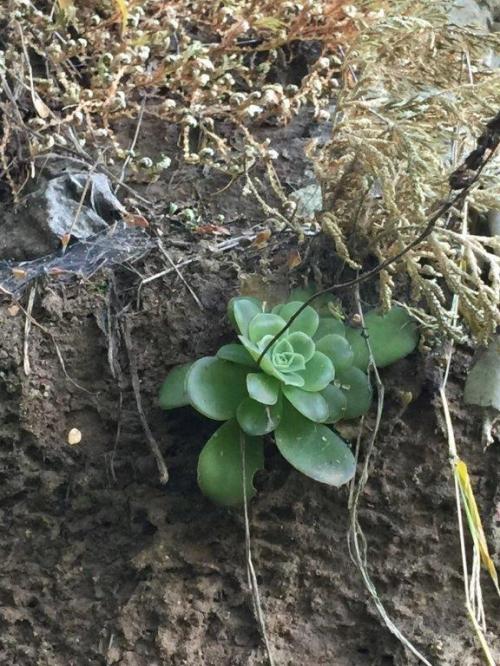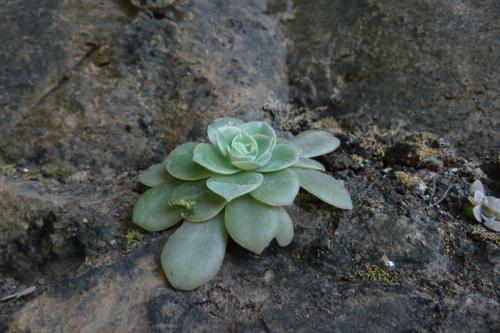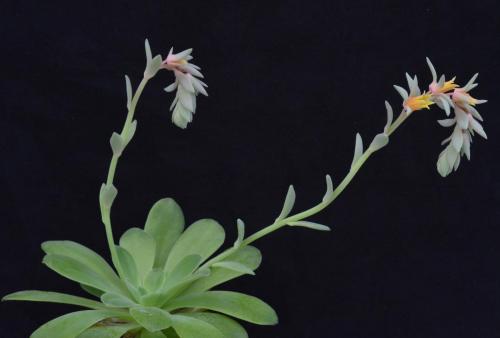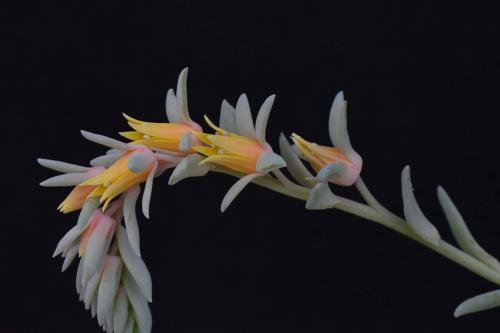CALYCOSA Moran, 1967 (engl./ fr.)
Series Valvatae
Type : Moran 13424.
Etymology : Referring to the conspicuous calyx.
Distribution : Mexico (Michoacán, 9 km south of Uruapan), growing in lichens on shaded vertical rocks at about 1'200 m.
First Description by Reid Moran in Cactus and Succulent Journal US 39(1), 14-16. 1967 :
Plant glabrous.
Caudex 0.5 - 1.5 cm thick, rarely 4 cm long, unbranched except apparently after injury.
Rosettes rather flat,5 - 10 (-15) cm wide, of 15 - 25 close-set leaves.
Rosette leaves light green, spatulate, rounded at the apex and weakly mucronate, 2.5 - 5 (-9) cm long, 1.5 - 2.5 (-3.5) cm wide above, 4 - 10 mm wide at the base, with one main vein branching shortly above the base and with usually two strong lateral veins entering separately, the margins acute, narrowly hyaline, entire, the mucro downturned and inconspicuous.
Floral stems at first nodding, becoming erect or ascending, green throughout or pink above, 5 - 20 cm tall (to the inflorescence), 1.5 - 3 (-5) mm thick at the base, bare in the lower 1 - 8 cm, with 4 - 11 ascending leaves above, the old stems often persisting firmly attached for several seasons. Stem leaves elliptic to oblanceolate, acute, short-spurred, scarcely reduced upward, 10 - 28 mm long, 3 - 8 mm wide, 2 - 3 mm thick. Cincinni mostly solitary, occasionally 2, rarely 3, circinate becoming erect, 2 - 21 cm long, with 5 - 38 flowers, the flowers opening at intervals of ca 3 days, at first pointing downward at ca 45°, rising to horizontal during anthesis, the bracts imbricated at first, elliptic, acute, sagittate-clasping, 7 - 15 mm long, 3 -6 mm wide, ca 1 mm thick. Pedicels pink, 2 - 5 mm long, 0.75 - 1.5 mm thick.
Flowers : Calyx pink at the base, light green above, the disk umbilicate, 3 - 5 mm wide, the segments ascending, markedly unequal, commonly the three upper ones about equal and the two lower much smaller but sometimes, even in the same inflorescence, four nearly equal and one much smaller or two larger and three much smaller, the upper laterals largest, oblong-lanceolate, acute, 9 - 13 mm long, 2 - 4.5 mm wide, the upper (middle) 3 - 11 mm long, 1 - 3 mm wide, the two lower triangular-acuminate, 2 - 10 mm long, 1 - 2 mm wide, the lower inner smallest. Corolla yellow above, suffused below with pink and thus appearing orangish below, pentagonal with flattened sides, 7.5 - 10 mm long, 4 - 6 mm wide at the base, 3 - 7 mm wide at the apex. Petals connate less than 0.5 mm, valvate, triangular-lanceolate, narrow-acute, ca 2.5 mm wide, obtusely keeled dorsally, broadly channeled ventrally, the nectar pit 1.5 - 2 mm from the base, somewhat flattened below, 0.5 - 0.6 mm wide. Anthers yellow......
Flowering time : July and August.
Cytology : n = 31
Note :
The closest relative is E. valvata. Both species have valvate (not imbricate) petals, a bicoloured calyx and comparatively long sepals.
In habtat :


Photos Gerhard Köhres
In cultivation :

